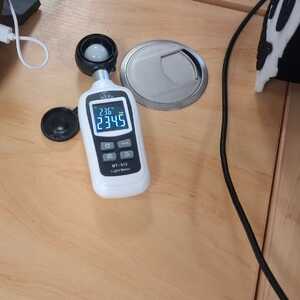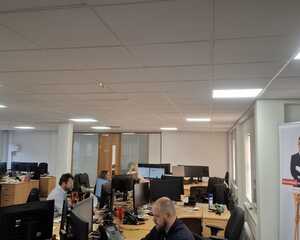Poor lighting design can have a direct impact on staff wellbeing
A recent project in York highlighted an issue we’ve seen in countless other offices. After switching to LED lighting, several employees began reporting regular headaches and eye strain.
But what was the cause of the complaints?
LED lighting can offer huge energy savings and improved performance over older fluorescent systems. But if it’s not properly planned, it can create uncomfortable and even unhealthy working environments. In this particular case, we were able to identify the cause and resolve it in a matter of hours – much to the relief of the staff.
Too much light can be just as bad as too little
In many offices, we see banks of ceiling lights turned off during working hours. Teams often take this into their own hands after realising that the lighting feels too harsh or bright. While the intention behind installing LEDs is usually positive, the result can be counterproductive if the lighting levels aren’t set to the needs of the space.
What many people don’t realise is that headaches caused by lighting aren’t simply a case of too much brightness. There’s often a combination of factors at play. Reflective surfaces, especially white paper and screens, can intensify the effect of over-lighting. Add in the wrong colour temperature, inconsistent glare, or subtle flickering, and the results can quickly become uncomfortable.
The right LED light for the right layout
The biggest issue we come across is how LED panels are installed. Many contractors carry out like-for-like replacements, swapping old fluorescent panels for LED units without redesigning the layout. This ignores one critical fact: LED panels emit more light over a wider area than their fluorescent counterparts.
Fluorescents also degrade quickly. Most tubes lose output within a few months and continue to deteriorate over time. Lighting plans were often designed with that in mind, building in redundancy to keep minimum levels consistent. LEDs, on the other hand, maintain their full output much longer. Replacing fluorescents with LEDs using the same layout can easily result in excessive lighting levels that cause eye fatigue.

Before a planned lighting upgrade

After a planned lighting upgrade

Light planning should start with the right measurements
When planning office lighting, the most reliable way to get it right is by working from LUX levels – not just the number of units. A well-designed LED system should provide the required light for desks and screens without overdoing it.
Screens now carry much of the visual load in most workspaces. That means overhead lighting should support, not overwhelm, the environment. As well as wasting energy, excess brightness creates discomfort, reduces productivity and in many cases leads to health complaints like headaches or migraines.
Getting it right means starting with your people
If your team has been experiencing discomfort after a lighting upgrade, it’s worth having your setup professionally assessed. Even simple changes to layout, output or colour temperature can make a major difference to how the space feels.
Upgrading from fluorescent to LED is still one of the smartest energy-saving moves a business can make. But it has to be done by an expert. A lighting system should be built around the space and the people who work in it. That’s what makes the difference between a bright, productive environment – and one that leaves your team reaching for the paracetamol.
Posted on November 17th 2025

